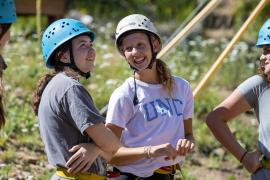The wise and enthusiastic Leslie Knope once said, “I care. I care a lot. It’s kinda my thing” (Scully & Miller, 2009).
To all parks and recreation professionals, we know you care. You care a lot. It’s absolutely your thing. And we are grateful.
According to the National Recreation and Parks Association (NRPA), there are more than 10,000 park and recreation agencies across the United States. In the past year, 275 million people visited a local park or recreation facility, and each year, approximately 40 million youth participate in at least one local park recreation program. These numbers alone show us that parks and rec programs matter. They matter a lot.
When we think of summer camp, we may focus on traditional programs — day and overnight camps, specialty programs, and more. We tend to think of camp as something that happens outside of our communities — a place away from home. The reality, however, is that many of our summer camp experiences are available in our own neighborhoods. Enter: parks and recreation.
Parks and rec programming goes beyond local green areas. It serves as a beacon in our communities, offering hope and solutions to common problems and concerns. Whether focusing on our children and youth, climate change, equitability, or fostering connections, it’s clear that we not only benefit from parks and rec but need it very much.
The need for parks and recreation first became apparent at the start of the 20th century. NRPA shares that with the rise of manufacturing, cities, urbanization, and green spaces grew increasingly smaller (NRPA, n.d.). Because of this, people sought safe spaces for children to play and had a desire to protect recreational areas. Sounds familiar, right?
People were becoming increasingly aware of the benefits of play and recreation, along with the therapeutic impact of spending time in nature. And just like the foundation of summer camps, the early age of parks and recreation programs set the stage for the incredible work that is ongoing today.
In addition to providing accessible areas for community building, environmental care, and leisure, parks and recreation organizations offer a wide variety of summer and year-round programs for children, youth, and families. And just like more traditional summer camps, these programs provide invaluable benefits for youth development, including time with peers, time to play and engage in physical activity, time spent in nature, time to try and to learn new things, and time nurturing mental and emotional health.
Parks and recreation professionals bring the benefits of camp experiences right into our communities. Because of parks and recreation programs, our neighborhoods are brighter, more caring, more connected, and more supportive.
So, here’s to all the parks and recreation programs out there. And here’s to all the Leslie Knopes. May you continue to care, and to care a lot. We sure do.
References
National Recreation and Parks Association. (n.d.). About. nrpa.org/about-national-recreation-and-park-association/
Scully, M. (Writer), & Miller, T. (Director). (2009, November 5). Ron and Tammy (Season 2, Episode 8) [TV series episode]. In G. Daniels, M. Schur, H. Klein, & D. Miner (Executive Producers), Parks and Rec. Deedle-Dee Productions; Universal Media Studios; Fremulon; 3 Arts Entertainment.
Photo courtesy of Andrew "Doc" Session Community Center in Fort Worth, TX.




